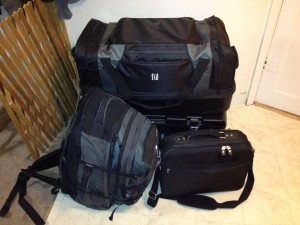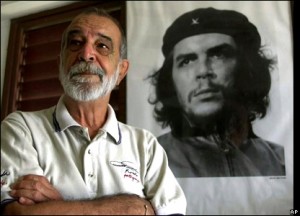 As I write this I am still wincing painfully from sore leg muscles when I climb stairs and stand up from sitting as a result of my most recent adventure – climbing Mount Chirripó, Costa Rica’s highest mountain. Climbing this 12,533-foot mountain up into high-altitude tropical climate was one of my two most recent adventures involving physically taxing undertakings in order to experience the raw natural beauty of Costa Rica that has gripped me and held me captive since I first arrived here. A few weeks ago, I took a Saturday to bike the Orosi Valley loop, a beautiful scenic road to the east of the greater metropolitan area (the San Jose capital and its outlying cities). It winds through lush green coffee fields, old colonial churches, follows the Reventazón river and crosses the dam, through some beautiful small towns and some breathtaking overlooks. Both experiences were physically pretty exhausting, but incredibly beautiful. And climbing Chirripó was the more difficult and culturally significant of the two. Continue reading
As I write this I am still wincing painfully from sore leg muscles when I climb stairs and stand up from sitting as a result of my most recent adventure – climbing Mount Chirripó, Costa Rica’s highest mountain. Climbing this 12,533-foot mountain up into high-altitude tropical climate was one of my two most recent adventures involving physically taxing undertakings in order to experience the raw natural beauty of Costa Rica that has gripped me and held me captive since I first arrived here. A few weeks ago, I took a Saturday to bike the Orosi Valley loop, a beautiful scenic road to the east of the greater metropolitan area (the San Jose capital and its outlying cities). It winds through lush green coffee fields, old colonial churches, follows the Reventazón river and crosses the dam, through some beautiful small towns and some breathtaking overlooks. Both experiences were physically pretty exhausting, but incredibly beautiful. And climbing Chirripó was the more difficult and culturally significant of the two. Continue reading
globalwanderer.net
not all who wander are lost
Author Archives: bdbhaiti
Sources of Inspiration
Introduction
If you’re curious at all what are sources of inspiration for me, here is a list of different people and works that have impacted my thinking. I find that I identify strongly with the writings or perspectives that these people bring, and I find their understanding of how the world works very applicable or challenging in the context I’ve lived.
Of course, these are publicly known figures that have impacted my thinking. They’ve written and produced a lot of good stuff that I consider to be the most interesting and inspiring ideas I’ve ever run into. I can’t claim expertise on any of them, except to say that what I have read from them has been very impacting to me and helpful in framing how things are. I’d say they are on the right track and have some really important commentary that speaks into how we live. This list doesn’t include people who have personally impacted how I live; I would need a separate list for that.
I’ll list off and clump together some of the principal influences, and include a short explanation of the aspects of their work that impact me most strongly. Continue reading
Visitors from Colombia
Earlier this month four youth from a church in Armenia, Colombia, completed their visit to Costa Rica as missionaries-in-training. During their time here they served in various ministries through the church I’m a part of (Amistad Internacional in San Francisco de Dos Ríos). They plugged right into the church and helped out tirelessly for about two weeks at our church VBS activities and different ministries members of our church are involved in (Funda Vida, YWAM, Latin Link in Los Guidos, Edutecnología, and a young church in Paraíso, Cartago). Each visiting missionary was placed with a family from the church while they were here. Continue reading
My life at <= 145 lbs and 275 linear inches... on leaving
 One way to simplify your life if you find yourself buried in an onslaught of senseless clutter is to move often, and as cheaply as possible, limiting yourself to the ever-reducing baggage restrictions that airlines have. Every time you make an overseas move, you have to prune off the useless junk you’ve accumulated over time.
One way to simplify your life if you find yourself buried in an onslaught of senseless clutter is to move often, and as cheaply as possible, limiting yourself to the ever-reducing baggage restrictions that airlines have. Every time you make an overseas move, you have to prune off the useless junk you’ve accumulated over time.
It’s no different for me, I find, even though I tried to keep myself from collecting clutter from creeping over my shelves and into my closets. I was unable to resist the temptation to accumulate more junk than I can use, but my sins catch up to me once departure date arrives. Departure date is the cutoff for when I have to whittle my excess down to the bare necessities, and make careful decisions about what’s worth taking and what stays behind.
What finally makes the cut tells me something about who I am, and is a somewhat sobering reminder about what the U.S. is known for in other parts of the world. Continue reading
Photography Ethics
Alberto Korda, the photographer made famous by his iconic image of Che Guevara gazing resolutely into the distance, considered the photograph a stroke of luck. Korda covered the Cuban revolution and became Fidel Castro’s personal photographer for ten years. Yet the image that changed him, that impacted his thinking and caused him to dedicate his life career to covering the revolution, is the transfixing photograph he took of a young girl cuddling a piece of wood as a doll.
“The photo I took that has been published throughout the world and is considered the most famous photograph in the history of photography is the photo of Che Guevara. But for me, in my heart and in my feelings, the most important photo is that of Paulita.”
~Alberto Korda
This American Life: Scenes from life back in the USofA
Greetings!
I apologize for the miserably long lapse of time since I’ve published some updated news. I hope that in the past several months, you’ve gotten some insight into what I’ve been up to via prayer letters, church presentations, or personal conversations. I’ve been back in the United States since May, so I’ve taken advantage of these past several months to try and meet personally with people (since I’m around to do it!), and also to share publicly at churches about the ministry work I’ve gotten to be a part of for the past several years in Costa Rica.
My prayer letters for this year are available on my MAF profile website: https://maf.org/blowers, in case you missed one of the exciting installments 🙂
A huge thanks to those of you who I’ve gotten to have conversations with. Many of these are a real encouragement to my soul. It is good to hear some of the things I’m processing reflected back for me. Of course, I come back a very different person than when I left four years ago. But it is a real encouragement to see and hear about the life I’ve been distant from for four years as well. That is, I am fascinated to hear about the interesting things going on in the lives of others that I’ve only been privy to via facebook updates and occasional notes.
While back in the U.S., home base has been the basement of home… that is, I’ve been living downstairs in my family’s home here in Nampa. I was able to visit a few other locations to spend time with family and share about ministry news: Oregon, California, Kansas City, Florida, and Oklahoma.
I’m working on a more detailed collection of thoughts and experiences that have impacted me since I’ve been back in the U.S. Until I get that done, take a look through the following photo albums and we’ll call it good:
- This American Life: Part California Love
- This American Life: Part Oklahoma/Texas
- This American Life: Part Nampa+Friends
- This American Life: Part Portlandia and Florida
Please know I am VERY grateful for the hospitality, kindness, and encouragement that so many have showed me since I’ve been back. It is very appreciated. Thank you also to those who have begun giving (or have been faithfully giving for many years) to help me be a part of this ministry.
Camera Obscura
If you’ve ever gotten the chance to sleep inside a “tin shack”, or a structure with walls and a roof of corrugated steel, you may have learned pretty quickly how the thin walls don’t separate you very well from what’s going on outside. In this case, immediately outside the room I’m describing is a dusty street, and although I am inside the room I can hear conversations from people outside my room talking late into the night. I can smell the frying foods from Coyol’s taco shack on weekends, the odor of exhaust when the neighbor leaves in the morning, or catch wafts of rancid smoke if someone has ducked into the alley to light up. There are lots of noises, too, like the tinkling giggles from kids jumping rope or playing “landa” (tag). The mornings are particularly noisy, with the fighting cocks crowing anywhere from 3 A.M. onward, dogs barking, and cars revving up. On weekends, a woman and child walk by selling “nacatamales,” singing-songing the word out shrilly as they walk the streets, drawing out each syllable in an unmistakable rhythm, each progressive syllable shorter than the one before it – “naaaaaaaaaacaaaaataaaamaaaales.”


 Greetings! I recently added a few interesting articles in my separate blog about living in La Carpio. There’s a lot of writing on there, so if you’re behind or even if you are checking it out for the first time, here are some articles you might want to start with:
Greetings! I recently added a few interesting articles in my separate blog about living in La Carpio. There’s a lot of writing on there, so if you’re behind or even if you are checking it out for the first time, here are some articles you might want to start with: